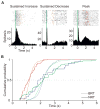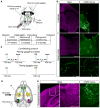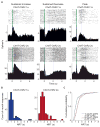Selective activation of a putative reinforcement signal conditions cued interval timing in primary visual cortex
- PMID: 26004763
- PMCID: PMC4470722
- DOI: 10.1016/j.cub.2015.04.028
Selective activation of a putative reinforcement signal conditions cued interval timing in primary visual cortex
Abstract
As a consequence of conditioning visual cues with delayed reward, cue-evoked neural activity that predicts the time of expected future reward emerges in the primary visual cortex (V1). We hypothesized that this reward-timing activity is engendered by a reinforcement signal conveying reward acquisition to V1. In lieu of behavioral conditioning, we assessed in vivo whether selective activation of either basal forebrain (BF) or cholinergic innervation is sufficient to condition cued interval-timing activity. Substituting for actual reward, optogenetic activation of BF or cholinergic input within V1 at fixed delays following visual stimulation entrains neural responses that mimic behaviorally conditioned reward-timing activity. Optogenetically conditioned neural responses express cue-evoked temporal intervals that correspond to the conditioning intervals, are bidirectionally modifiable, display experience-dependent refinement, and exhibit a scale invariance to the encoded delay. Our results demonstrate that the activation of BF or cholinergic input within V1 is sufficient to encode cued interval-timing activity and indicate that V1 itself is a substrate for associative learning that may inform the timing of visually cued behaviors.
Copyright © 2015 Elsevier Ltd. All rights reserved.
Figures
Similar articles
-
Visual Cues Predictive of Behaviorally Neutral Outcomes Evoke Persistent but Not Interval Timing Activity in V1, Whereas Aversive Conditioning Suppresses This Activity.Front Syst Neurosci. 2021 Mar 5;15:611744. doi: 10.3389/fnsys.2021.611744. eCollection 2021. Front Syst Neurosci. 2021. PMID: 33746718 Free PMC article.
-
The Timing of Reward-Seeking Action Tracks Visually Cued Theta Oscillations in Primary Visual Cortex.J Neurosci. 2017 Oct 25;37(43):10408-10420. doi: 10.1523/JNEUROSCI.0923-17.2017. Epub 2017 Sep 25. J Neurosci. 2017. PMID: 28947572 Free PMC article.
-
Theta Oscillations in Visual Cortex Emerge with Experience to Convey Expected Reward Time and Experienced Reward Rate.J Neurosci. 2015 Jul 1;35(26):9603-14. doi: 10.1523/JNEUROSCI.0296-15.2015. J Neurosci. 2015. PMID: 26134643 Free PMC article.
-
Vision: how to train visual cortex to predict reward time.Curr Biol. 2015 Jun 15;25(12):R490-2. doi: 10.1016/j.cub.2015.04.048. Curr Biol. 2015. PMID: 26079076 Review.
-
Envisioning the reward.Neuron. 2006 Apr 20;50(2):188-90. doi: 10.1016/j.neuron.2006.04.008. Neuron. 2006. PMID: 16630831 Review.
Cited by
-
Visual Cues Predictive of Behaviorally Neutral Outcomes Evoke Persistent but Not Interval Timing Activity in V1, Whereas Aversive Conditioning Suppresses This Activity.Front Syst Neurosci. 2021 Mar 5;15:611744. doi: 10.3389/fnsys.2021.611744. eCollection 2021. Front Syst Neurosci. 2021. PMID: 33746718 Free PMC article.
-
Cholinergic activity reflects reward expectations and predicts behavioral responses.iScience. 2022 Dec 16;26(1):105814. doi: 10.1016/j.isci.2022.105814. eCollection 2023 Jan 20. iScience. 2022. PMID: 36636356 Free PMC article.
-
The neural bases for timing of durations.Nat Rev Neurosci. 2022 Nov;23(11):646-665. doi: 10.1038/s41583-022-00623-3. Epub 2022 Sep 12. Nat Rev Neurosci. 2022. PMID: 36097049 Review.
-
The Role of Multiple Neuromodulators in Reinforcement Learning That Is Based on Competition between Eligibility Traces.Front Synaptic Neurosci. 2016 Dec 15;8:37. doi: 10.3389/fnsyn.2016.00037. eCollection 2016. Front Synaptic Neurosci. 2016. PMID: 28018206 Free PMC article.
-
Coordinated Acetylcholine Release in Prefrontal Cortex and Hippocampus Is Associated with Arousal and Reward on Distinct Timescales.Cell Rep. 2017 Jan 24;18(4):905-917. doi: 10.1016/j.celrep.2016.12.085. Cell Rep. 2017. PMID: 28122241 Free PMC article.
References
-
- Leon MI, Shadlen MN. Representation of time by neurons in the posterior parietal cortex of the macaque. Neuron. 2003;38:317–327. - PubMed
-
- Mita A, Mushiake H, Shima K, Matsuzaka Y, Tanji J. Interval time coding by neurons in the presupplementary and supplementary motor areas. Nature neuroscience. 2009;12:502–507. - PubMed
-
- Dayan P, Niv Y. Reinforcement learning: the good, the bad and the ugly. Curr Opin Neurobiol. 2008;18:185–196. - PubMed
Publication types
MeSH terms
Grants and funding
LinkOut - more resources
Full Text Sources
Other Literature Sources
Research Materials
Miscellaneous








